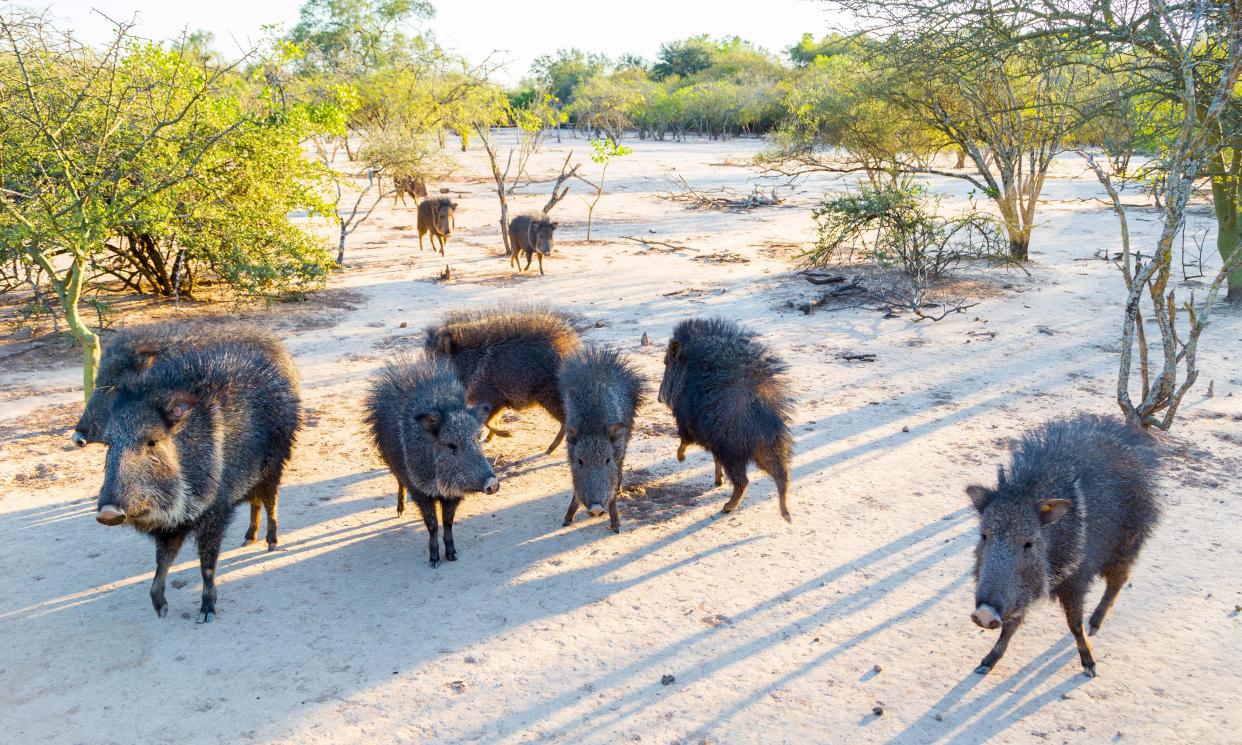Deforestation piles pressure on South America’s elusive Chacoan peccary

The Chacoan peccary is so elusive that scientists believed it was extinct until its “discovery” in 1975. Today, only 3,000 remain in the inhospitable forests and lagoons of the Gran Chaco region, which stretches across northern Argentina, Paraguay and southern Bolivia, and comprises more than 50 different ecosystems.
Micaela Camino, who works with the Indigenous Wichí and Criollo communities to protect the animals and their land rights in Argentina, knows how difficult to find they can be. She has only seen one Chacoan peccary, or quimilero, in 13 years since she set up her NGO, Proyecto Quimilero, but has fallen in love with the critically endangered mammal, which looks like a peculiar cross between a boar and a hedgehog.
“I was told that the Chacoan peccary was extinct outside protected areas when I first started,” says Camino. “So when we found it, I thought it was great. We set up monitoring to find more in one of the most isolated parts of the dry Chaco. But then the loggers started to come.”
The Gran Chaco, South America’s second-largest forest after the Amazon, is one of the most deforested places on Earth. Every month, more than 133 square miles is lost, cleared for vast soya farms and cattle ranches that export to markets in the US, China and Europe – including UK supermarkets, according to a joint Guardian investigation in 2019. However, the loss is largely ignored on the international stage, receiving little conservation money or celebrity attention in comparison with the Amazon.
In the area where Camino works, the land clearing was turbocharged by Argentina’s 2001 economic collapse. Tree loss highlighted by Global Forest Watch shows the extent of the damage over the past 20 years. The area is home to charismatic species such as the maned wolf, the giant armadillo and the jabiru, many of which are not found anywhere else on Earth.
At current rates of deforestation, the mosaic of life in the Gran Chaco could collapse entirely. The loss of the Chacoan peccary would be guaranteed this time. Unlike the Amazon, there are few academic studies on tipping points and the forest’s waning ability to support itself as the climate changes and land is cleared, but people who live here are seeing the changes.
“The Chacoan peccary cannot survive with such a rapid advance of deforestation. It doesn’t exist anywhere else. Locally, the animal is a good flagship. Jaguars and pumas are charismatic but nobody really likes these animals in the forest,” says Camino.
More than 140 countries, including Argentina and Paraguay, signed an international agreement at the Cop26 climate summit in Glasgow in 2021 to halt and reverse deforestation by 2030. However, economic realities have complicated the picture. Argentina’s economy is collapsing once again, with the annual inflation rate in 2022 hitting its highest level in 30 years, and the country is desperate for dollars, which can be earned by trading commodities such as soy and beef.
Related: Rocky road: Paraguay’s new Chaco highway threatens rare forest and last of the Ayoreo people
In Paraguay, the success of Mennonite communities has transformed the country into one of the most important beef producers in the world, largely at the expense of the forest, dubbed “the green hell” by early settlers from Canada.
“The Gran Chaco has been at a crossroads for a long time,” says Gastón Gordillo, a professor of anthropology at the University of British Columbia. “The 2007 forest law in Argentina did manage to slow some deforestation, but it also created the paradox by establishing legitimate ways of destroying the forest.”
Before the Covid pandemic, civil society organisations teamed up to launch the 2030 initiative to protect what is left of the Gran Chaco in Argentina, the part most affected by land clearing. They called for a change in the economic model of the region, urging local and national governments to move away from extraction, and pushed for greater compliance with forest law. However, a new motorway in Paraguay appears likely to open up more of the region to ranching.
“The agribusiness sector in Argentina is very powerful,” says Gordillo. “We are going through a profound economic crisis. There is a lot of anxiety about what is going to happen. The major concern for the government right now is to get US dollars, and exports from the agribusiness sector are the main source. That means there’s a strong incentive to continue.
“The dichotomy is clear. You either continue destroying forests and the environment or you don’t. But this is an uneven confrontation, unfortunately.”
For the Chacoan peccary, research indicates there are only 30 years left to save the species, with current deforestation rates meaning all of its habitat outside protected areas will have gone by 2051.
Camino’s conservation efforts, for which she won a 2022 Whitley prize, will focus on priority areas for saving the mammal and helping local people to resist corporate land grabs and stay in their Indigenous lands. She hopes the mammal can become a flagship species to protect the region.
“The only way we can save the Chacoan peccary is by protecting the forest. It represents a unique evolutionary path. It’s an umbrella species for working with the whole ecosystem,” she says.
Find more age of extinction coverage here, and follow biodiversity reporters Phoebe Weston and Patrick Greenfield on Twitter for all the latest news and features

 Yahoo Movies
Yahoo Movies 
